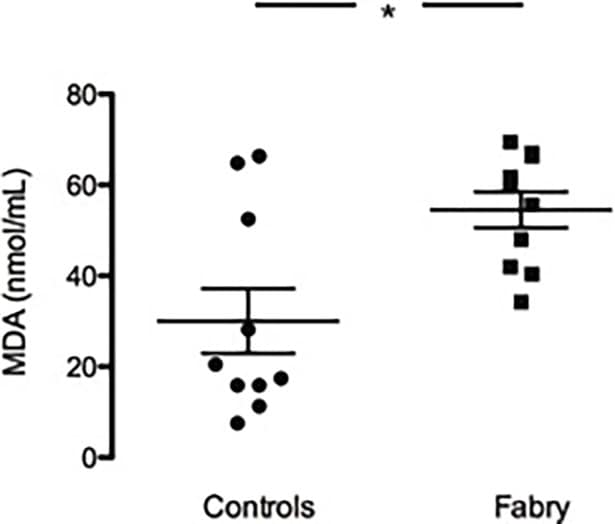Lipid Peroxidation (MDA) Assay Kit (Colorimetric/Fluorometric) (ab118970)
Key features and details
- Assay type: Quantitative
- Detection method: Colorimetric/Fluorometric
- Platform: Microplate reader
- Assay time: 1 hr 20 min
- Sample type: Cell culture extracts, Plasma, Tissue Extracts, Urine
- Sensitivity: 0.1 nmol/well
Overview
-
Product name
Lipid Peroxidation (MDA) Assay Kit (Colorimetric/Fluorometric)
See all Lipid Peroxidation kits -
Detection method
Colorimetric/Fluorometric -
Sample type
Urine, Plasma, Cell culture extracts, Tissue Extracts -
Assay type
Quantitative -
Sensitivity
> 0.1 nmol/well -
Assay time
1h 20m -
Product overview
Lipid Peroxidation (MDA) Assay Kit (Colorimetric/Fluorometric) (ab118970) provides a convenient tool for sensitive detection of malondialdehyde (MDA).
In the lipid peroxidation assay protocol, the MDA in the sample reacts with thiobarbituric acid (TBA) to generate a MDA-TBA adduct. The MDA-TBA adduct can be easily quantified colorimetrically (OD = 532 nm) or fluorometrically (Ex/Em = 532/553 nm). This assay detects MDA levels as low as 1 nmol/well colorimetrically and 0.1 nmol/well fluorometrically.
The MDA assay is also refered to as a TBARS assay.
Lipid peroxidation assay protocol summary:
- add TBA solution to samples and standards, incubate at 95ºC for 60 min, cool in ice bath for 10 min
- transfer to wells of microplate
- analyze with microplate reader
For higher sensitivity, precipitate with n-butanol, centrifuge, dry and resuspend pellet before analysis.Chinese protocol available. See protocols section below.
For an alternative MDA assay, without the heating steps required in the TBARS assay, try MDA assay ab233471.
-
Notes
Lipid peroxidation refers to the oxidative degradation of lipids. In this process free radicals take electrons from the lipids (generally in cell membranes), resulting in cell damage. Quantification of lipid peroxidation is essential to assess oxidative stress. Lipid peroxidation forms reactive aldehydes such as malondialdehyde (MDA) and 4-hydroxynonenal (4- HNE) as natural bi-products. Malondialdehyde (MDA) and 4-hydroxynonenal (4-HNE) are often used as markers of lipid peroxidation, and to assay for oxidative damage / oxidative stress.
Related products
Review the oxidative stress marker and assay guide, or the full metabolism assay guide to learn about more assays for metabolites, metabolic enzymes, mitochondrial function, and oxidative stress, and also how to assay metabolic function in live cells using your plate reader.
Also see the popular 4-HNE Assay Kit ab238538 as an alternative marker of lipid peroxidation and oxidative stress.
How other researchers have used Lipid Peroxidation Assay Kit ab118970The MDA/TBARs assay kit has been used in publications in a variety of sample types, including:
- Human: serum1, hippocampal primary cell extracts2, A375 cultured cell lysates3, plasma and platelet samples4
- Mouse: neuronal cell lysates5, heart tissue extract6, plasma7, cell extracts8
- Rat: hippocampal tissue extracts9, cardiomyocyte extracts of cultured cells10, lung lysates11
- Pig: serum12References: 1 - Shen J et al. 2018, 2 - Wang Q et al. 2019, 3 - Luo M et al. 2018, 4 - Mustafa AG et al. 2018, 5 - Murphy K et al. 2018, 6 - Guan F et al. 2019, 7 - Costa CRC et al. 2018, 8 - Eleftheriadis T et al. 2019, 9 - Malekiyan et al. 2019, 10 - Zhou Z et al. 2018, 11 - Li L et al. 2018, 12 - Lee SE and Kang KS 2019
-
Platform
Microplate reader
Properties
-
Storage instructions
Store at -20°C. Please refer to protocols. -
Components Identifier 100 tests BHT (100X) Purple 1 x 1ml MDA Lysis Buffer WM 1 x 25ml MDA Standard (4.17M) Yellow 1 x 100µl Phosphotungstic Acid Solution NM 1 x 12.5ml TBA NM 4 vials -
Research areas
-
Relevance
Lipid peroxidation refers to the oxidative degradation of lipids and is a well-defined mechanism of cellular damage. The formation of lipid peroxidation products leads to spread of free radical reactions leading to cell damage. -
Alternative names
- TBAR
- TBARS
Images
-
Lipid Peroxidation Assay performed on mouse sciatic nerve samples Image courtesy of Hichor et al. Sci Rep. 2018; 8: 2524. doi: 10.1038/s41598-018-20980-3. Reproduced under the Creative Commons license http://creativecommons.org/licenses/by/4.0/.Hichor M et al. used the TBARS assay / MDA assay ab118970 to study the role of LXRs in the regulation of oxidative stress in peripheral nerves.They identified that in sciatic nerves in LXR knockout mice (LXRdKO), the MDA concentration was significantly increased, and that this was corrected by the treatment of mice with the anti-oxidant ROS scavenger N-acetylcysteine (NAC).
-
 Lipid Peroxidation measured with MDA assay in Fabry patients and healthy controls Image courtesy of Ravarotto V et al. PLoS One. 2018; 13(9): e0204618. doi: 10.1371/journal.pone.0204618. Reproduced under the Creative Commons license http://creativecommons.org/licenses/by/4.0/.
Lipid Peroxidation measured with MDA assay in Fabry patients and healthy controls Image courtesy of Ravarotto V et al. PLoS One. 2018; 13(9): e0204618. doi: 10.1371/journal.pone.0204618. Reproduced under the Creative Commons license http://creativecommons.org/licenses/by/4.0/.Ravarotto V et al. used Lipid Peroxidation Assay Kit ab118970 to assess oxidative stress in Fabry disease. They identified that MDA levels are higher in Fabry patients, indicating higher levels of oxidative stress.
The MDA concentration was measured in plasma from Fabry patients compared to healthy control patients. Data are shown ±SEM. *: p = 0.01.
-
Typical MDA standard calibration curve using colorimetric reading.
-
Typical MDA standard calibration curve using fluorometric reading.
-
Measurement of MDA in human plasma (20 µl) and rat liver lysate (10 mg).













